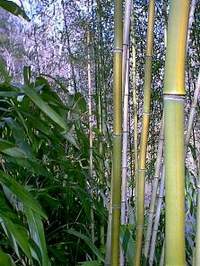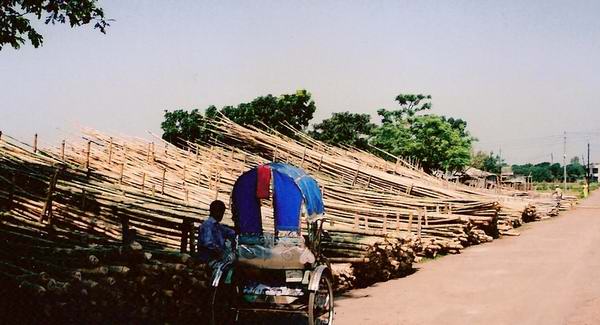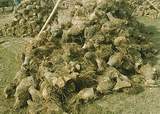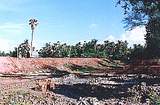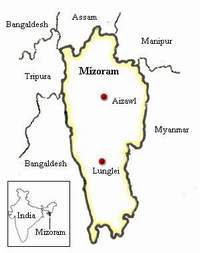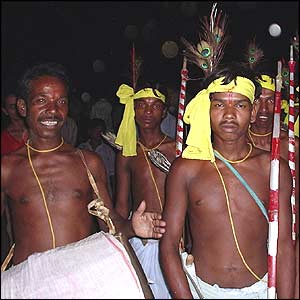Please View Sponsored Advertisements to Support this Site and Project
Bamboo the life blood of the people: Alarm to Ecosystem
CONTENT
1. INTRODUCTION
Bamboo occupies an unparalleled position in the plant kingdom in terms of its distribution, diversity and uses in the tropics and subtropics. In addition to featuring prominently in the lives of rural communities, particularly in Asia, it continues to find new applications in such wide ranging areas as paper and rayon manufacture; construction; architecture; engineering; handicrafts; food and medicine.
Bamboo is a grass belonging to the family Poaceae. It is an enduring, versatile and highly renewable resource found naturally on every continent except Europe. The growing stock of bamboo is estimated at over a 100 million tonnes spread over forest areas, homesteads and private plantations. Of the 20 million tonnes harvested every year, almost three-fifth is from India and China. China has emerged as a pioneer in bamboo products, with the contribution of these products to the Chinese economy estimated at over 30 per cent. Most Bamboo originated in Asia and India. It grows wild throughout southern and western China, where for thousands of years it has been used for food, building material, garden material, visual pleasure, and a symbol of strength through flexibility. Meng Tzu, a philosopher in the 4th century BC described 'large gardens in ancient China which contained trees, flowers, animals and Bamboo used as a growing plant and all sorts of garden construction.'Bamboo was common and widespread throughout the ancient oriental world, and yet if you search for old oriental paintings or literature dealing with Bamboo, you find it used as a background or symbol suggesting stability and longevity, rather than as a primary subject.
A string of surprise innovations from the grassroots level has been thrown up by the attempt to popularise appropriate technology, said department of science and technology secretary V S Ramamurthy here. “A man in Arunachal Pradesh has developed an artificial tooth using bamboo. It is both tough and durable and at a price of Rs 20 (50 Rs. = 1 US Dollar) a tooth, it is amazingly cheap. The innovator has successfully helped people in his neighbourhood,” he said, pointing out that it would not be possible to even meet the consultation fee of dentists with the amount.
The Times of India, Nov. 30, 2003
Often in oriental art, after the grace, calm and stability of Bamboo has been established, the work is then ornamented with passion - or perhaps there was more passion in ancient India? From this song, which was sung each year at medieval rice-planting festivals it appears. Bangladesh's Bamboo gardens were not just used for sitting and gazing:
"My flute is lost on the sandbank,
How shall I return home without it?
The soft touch of grass
Lossens my ankle bells.
They don't sing any more, as I sing."
Jasim UddinDuring the 7th century many Chinese gardening manuals began to appear. One of the most complete works, 'Yuan Yeh' advises 'siting gardens in private, out-of-the-way locations made to last a thousand years and planting Bamboo groves to provide a stillness for captivating the heart'. Bamboo was painted in a dedicated manner before 600 AD with painstaking care, outlining stems and leaves in ink and then filling in with body color. By 900 such paintings of Bamboo had become a cultural craze throughout China.
The great Mongol emperor Kublai Khan sent his troops south to conquer all of China in the 13th century. Mongol hordes rolled over China and ravaged and conquered the people; later they settled down and absorbed their culture. Khan became Emperor of all China in 1280. During this period, called the Yuan Dynasty 1260-1368, while China was being ruled by outsiders, the painting of Bamboo with brush and monochrome ink on paper became an important art form which was practiced with great personal intensity and privacy. The style required the artist to master painting composition, brush control, and calligraphy, as well as knowledge of Bamboo.
When Marco Polo returned from China in 1298 he described Hangchow as "The Greatest City in The Whole World", and went on at length describing the beauty, extent, and grandeur of Chinese gardens. He also recorded that since at least 200 BC the Chinese had been using bronze drill bits in Bamboo casings to drill down as far as 3,500 feet to create oil and water wells.
In the last 150 years there has been a growing awareness of Bamboo in Europe and America. The first Bamboo known to be imported into Europe was Black Bamboo, and the year was 1827. Japonica followed in 1850, Shibataea kumasaca in 1861, and viridistriata in 1870.
In 1855 Eugene Mazel, a frenchman who made a fortune importing spices from Asia, bought 34 hectares of land in southern France and began developing it as a large bamboo garden, which became known as 'Prafrance,' or 'La Bambouseraie.' Today it is one of the most famous and impressive gardens in the world, visited by thousands of people every year.
In the 1920’s the USDA enthusiastically promoted Bamboo as a wonderful crop for small American farms. They described fencing, trellises, poles, bird shelters, windbreaks, hedges, screens, forage, food, building construction, furniture, concrete reinforcing and the manufacture of paper. A major problem in their campaign was the lack of large quantities of Bamboo for propagation, lack of a labor force familiar with the material, and the commitment of the U.S. building and furniture industries to steel, aluminum, and plastic.
Today China is the largest producer of Bamboo. Two-thirds of Chinese Bamboo is Moso, which is used to make furniture, scaffolding, concrete reinforcing and twisted cables for buildings and bridges. Tonkin Cane (Arundinaria amabilis) is exported for plant supports, ski poles, fishing rods, and furniture. And all Chinese grow Bamboo to eat in their family gardens
India has large forests of Dendrocalamus, which is used for construction of buildings, furniture, and farming tools, as well as food. It is used for reinforcing concrete. And 66% of the paper in India is made from Bamboo.
Commercial applications
Wood substitutes and bamboo composites Activated carbon Bamboo shoots utilised for food and agro-processing Bamboo composites
Indiscriminate deforestation has led to an environmental imbalance and therefore cutting of forest trees has been banned in many countries. In contrast to hardwood species, which take 80-100 years to mature, bamboo is highly renewable with two to four years of maturity cycle.
Bamboo is the life blood of the people of Bangladesh and India
Another example of destruction of most valuable item for house construction is bamboo in Bangladesh. In Bangladesh a large quantity of bricks are produced for building, road constructions etc., and these are produced at the cost of fertile soil and a huge amount of irreplaceable urban forest resources. All types of valuable trees such as fresh roots of the bamboo, which are invaluable for the reproduction, are ruthlessly burnt for brick production. In many areas these are the only source of cash money for the landless and poor farmers. It requires about 28 metric tonnes of wood to produce about 100,000 brick.
Indiscriminate use of bamboo clusters in brickfield kilns : Cottage industry facing set-back
NARAIL, Nov. 30:—The construction of new houses and repair of old ones are being hampered greatly for want of bamboo. The traditional cottage industry depends on bamboo is facing a set-back for want of bamboo. A large number of bamboo groves have been destroyed by the unscrupulous farmers by selling roots of the bamboos to the owners of brick fields.
Bamboos are widely used in construction of houses in rural areas. About 90 per cent of the dwelling houses in the district are kutcha. Besides household goods such as baskets, bamboo made strainers, fish creel, fish catching pail, big wicker basket, bamboo tally and other necessary articles are made with bamboo in rural and urban areas. In the face of acute bamboo scarcity people engaged in cottage industry may give up their traditional profession and bamboo made industry may face extinction throwing hundreds of men and women connected with these small industries out of employment.
Price goes up
The price of bamboo has gone up sharply. At present the price of medium size bamboo ranges from Taka 70 to Taka 90. As such 80 per cent people can not afford to buy bamboo at an exhorbitant price. Consequently most of the people can not repair their houses. During the Bengali months of Baishakh and Jaistha many of the dwelling houses in rural areas are either blown away by storm or damaged by heavy rainfall. These houses cannot be repaired for want of bamboo and high price (The Bangladesh Observer, December 1, 2003)..
When the bamboo flowers, famine, death and destruction follow
Bamboo forest covers 12,54,400.00 ha out of the total area of 21,090 sq.Km. of the Mizoram State. The bamboo forest contributes to 14% of all India bamboo area of 8.96 million ha, which further constitutes 11.71% of the 74.96 million ha of forest area of the country. The total bamboo yield of Mizoram is 32,37,689 MT/Year. Bamboo is distributed thoroughly between 40 - 1520 m altitude of Mizoram.
Now comes the news of the bamboo having flowered in several areas-something that the local people regard as a bad omen. People here not only believe that bamboo- flowering foretells impending natural disasters such as untimely floods and earthquakes, but also famine, a large-scale one like that in the early 60s, which had led to an emergency situation in the Lushai hills of Assam, now known as Mizoram.
A total of 23 species of bamboo have been identified in the forest of Mizoram.
People in Assam regard the bamboo-which is really a grass-as a sacred tree and a close friend of mankind, having supported human civilisation through the ages by providing the material and wherewithal for daily living. It provides food, construction material, agricultural implements, baskets, as well as furniture.So valuable a role does this plant play in people’s lives that the Assamese, as well as their tribal counterparts in the neighbouring region, do not cut the bamboo during certain auspicious periods, like on a full moon day or on Saturdays and Tuesdays.
When the bamboo flowers, famine, death and destruction will soon follow, goes a traditional saying in Mizoram, the tiny hill state in north-east India. Who better than the hardy Mizos would know this, considering that theirs is probably the only land on earth where history is closely intertwined with the mysterious cycle of bamboo flowering. Back in 1959, bamboo flowering in the state set off a chain of events in the rugged hilly state that ultimately led to one of the most powerful insurgencies against the Indian union spanning over two decades
2. Bamboo flowering - gregarious
There are hundreds of species of bamboo in the world. Some flower every year, some at irregular intervals. But a small percentage flowers in synchrony, over hundreds of square kilometers, every few decades. Researchers aren't sure how it happens.
"Science has to date not been able to explain how the same message is passed among bamboo clumps separated by hundred of kilometers to flower at the same time, said botanist H. Y. Mohan Ram of the University of Delhi, who is one of the country's foremost authorities on bamboo. He speculates that the rhizomes of the bamboo have some kind of "memory" trait that makes the plants grow in synchronization, then burst into bloom all at the same time. After the massive flowering, the bamboo clumps die, in what Mohan Ram calls "a kind of suicide by over-production."
Folklore apart, scientists say that the strange phenomena of bamboo flowering, called 'gregarious bamboo flowering' because the bamboo clumps flower all at the same time only once in the plants' lifetime, wreaks ecological havoc because of two reasons:
First, bamboo plants die after flowering. It will be at least some years before bamboo plants take seed again, leaving bare exposed soil - which could be disastrous in mountainous states - and also leading to food scarcity, since animals depend on bamboo plants. The second factor is that rats feed on the flowers and seeds of the dying bamboo tree. This activates a rapid birth rate among the rodents, which leads to the huge rat population feeding on agricultural crops in the fields and granaries and causes famine.
More on Bamboo Flowering
Bamboo, Dendrocalamus strictus, flowered gregariously in Maharashtra in the year 1983-84. Bamboos of same species flowered also in Madhya Pradesh and Andhra Pradesh in following years. Flowered bamboo was allowed to complete the flowering, and then seeding. Meanwhile the state made preparations for harvesting the dry bamboo after the seeding was completed everywhere; this is followed by toppling down of the bamboo clumps. This takes a period of two-three years. Only when the clumps start falling is the harvesting undertaken. Harvesting is done systematically and in a short period of six months, before start of monsoon (in late June in Maharashtra), all dry bamboo is cut and carried away from bamboo areas. Monsoon starts the profuse regeneration of bamboo seedlings.
This is very delicate period for the life of new bamboo and hence strict protection against fire and cattle grazing is called for. These seedlings take 4-6 years to establish and the new bamboo crop is ready in 7-8 years for systematic and scientific harvest for next life cycle of 45-48 years. Incidentally, we in Maharashtra and other two states did not cut or remove any flowered bamboo from wild life protected areas, because flowering and drying and further degradation of bamboos in situ is itself an ecological event.
Bamboo flowering is a natural phenomenon. It is preceded by increase in rodent population, a nature’s way of controlling profuse seeding. Bamboo seeds are eaten by rats, cattle as well as people. It is quite nutritious and even some believe that bamboo seed is also invigorating and has aphrodisiac qualities.
It is also reported in your article (‘Mizoram: Identity and Accommodation’, EPW, November 1) that International Bamboo and Rattan Network and UNIDO have been approached for advice and help. Indian foresters are qualified and experienced enough in such matters and I hardly find any role of these international agencies. We also have plenty of funds in foreign exchange and need no funds from abroad. These are also some misconceptions perpetuated by vested interests. One must remember that there is no free lunch anywhere in this world. And our experience in forestry field, of foreign funding agencies and their expertise is not quite encouraging so far. Some of us have been sacrificing long-term interests for short-term gains. It is a problem of management and I am sure our foresters in NE are capable of handling it. (A R Maslekar , EPW, Dember 13, 2003).Consequence
In 1991-12, many people moved away from their native village to settle as far as Tripura, Manipur and Western Burma. A man of Lalhrima’s village fetched rice from 35 kms away and a night before he reached home, he developed a cholera symptoms. The poor man was dragged out of the village before he was dead and buried there by his family. The family even did not return to the village and stayed in a thlam. That night, all people from his veng ran away of the village in all directions to the jungle and to make thing worse a dangerous thunderstorm assaulted them.
In 1959-60, a sever famine followed bamboo flowering. There was severe starvation and the common mass had general feeling of neglect by the Indian Government. This led to rebellion and MNF gone underground which lasted for 20 years costing numerous dear lives and heavy casualties
Now, the bamboo is going to flower again within the next four to five years, say experts. And this time, it's not going to be just in Mizoram, but in the huge bamboo forested areas across the other north eastern states of Tripura, Manipur and Southern Assam.
It was precisely this scenario in Mizoram in the late 1950s, when the authorities failed to respond with quick famine relief.
What would happen to common rural northeasterners who depend on bamboo for almost everything - from a raw material to build their homes to food, and as one of the few sources of cash. Bamboo rotting over hundreds of acres and the growth of the rat population will have a devastating effect on the jhum (slash and burn) cultivation on which a majority of the rural folk still depend for growing food, thus affecting the already precarious food security of the rural people:
Water, which is already a scarce resource in most of the hills, will become scarcer, the Mizoram experience shows. Experts say that during the bamboo flowering in Mizoram in the late 1950s and '60s, there was a sharp rise in temperature followed by a spell of dry arid weather, which had a direct fallout on the health of the people. Not only that, women and children who have to spend hours to fetch water will be forced to spend even more time carrying out this task. Sporadic flowering of m.beciferra and d.hamiltonii started in 2001 and seeds of m.baciferra are available every year during late May to early August. From the initial observation of m.baciferra seeds falling on the ground in the forest, juice and seed part in the interior of the seed are eaten away by rats. In the earlier flowering of bamboo in Mizoram, it is said that rodent population are feasting on these bamboo seeds and multiple themselves in terms of ten thousands in a year and once, the bamboo seeds are no longer available to them, they finished away all agriculture products in a day migrating from place to place in thousands and thousands numbers. Henceforth, severe famine is the unavoidable circumstances.
UN/FAO was basically responsible for both the death of the bamboo forests
D. N. Tiwari, a member of the government's Planning Commission, said officials were also considering other measures, such as replacing flowering varieties of bamboo with non-flowering ones. Mohan Ram views such an approach as "outlandish." He believes the only way to avert the cyclical famine associated with bamboo flowering is to teach farmers to plant crops that rats do not eat, such as ginger and turmeric, during the periods when vast fields of bamboo are expected to flower (Pallava Bagla, National Geographic News ,June 22, 2001).
Manura Savur describes (EPW, Nov. 15, 2003) that the UNFAO was basically responsible for both the death of the bamboo forests and the destruction of the forest ecosystem in the entire bamboo region of the southern and central India from 1960 onwards. The north-east region was mercifully spared as FAO had not entered that region.The function of a flower is to produce seed (enriched by cross-fertilisation) to perpetuate its species. This is true of bamboo too, except that each species of the bamboo tends to flower gregariously over vast stretches of areas, but only at the end of its vegetative growth which varies from one to 120 years for different species. This implies that while any one species is flowering gregariously all other species of bamboo in that region will continue to live and vegetatively produce their culms. There is no ready information regarding the exact number of species that thrive in Mizoram. According to D N Tiwari (Bamboo, ICFRE, Dehradun, not dated), eastern India alone harbours more than 50 per cent of the 125 known species in India. And Mizoram falls in this region.
The second alarming fact is the central government's threat to harvest the bamboos before they flower. If an important species is clear-felled before it flowers and its rhizomes having reached the end of the physiological cycle are exhausted, it would mean a death, a criminal 'murder of a species'. Do the UNIDO and the central government care? In fact the people of Mizoram and the whole of north-east would. Bamboo is the life blood of the people and the saviour of that ecosystem. It is the green gold of the region. Clear-felling would lead to political upheaval in that sensitive region.
Gregarious flowering does not portend famine. On the contrary, famine which is often the result of serial drought also results in gregarious flowering of the bamboo across the species – a defensive measure, a simple survival strategy of the species to seed, reproduce and perpetuate itself. Bamboo is a grass, rigid and woody with lignin but essentially a cellulose, a carbohydrate with a large water component. Good rainfall or running water (i e, a stream) is essential for its survival and growth. Water is both an agent of nutrient distribution in nature and a significant medium of biological activity in plants. Repeated failure of the monsoon rings the death knell for bamboo.
The fear of rodents is real. It has to be tackled by the central government. Bamboo is a grass, so too are wheat and rice which bear edible seeds that both humans and rodents devour. If rodents are kept at bay in the ripening grain fields and from storehouses, why not from the ripening seeds of the bamboo? GoI should also gather strength to keep UN organisations at bay – and save the sensitive north-east ecosystem from disaster.
3. Bamboo forests withering away in Rangamati hills
Elders describe it ominous, KPM officials apprehend crisis of raw material
Bamboo clusters on vast areas of Rangamati are withering away after flowering and bearing fruit. Indigenous people of different communities said this is an ominous sign in the hills. Elders said flowering and fruiting of bamboo foretell natural calamities, crop failure and famine in hills. The worst affected areas are Sazek union in Baghaichhari upazila and Kawkhali, Barkal, Rajasthali and Bilaichhari upazilas. Two-thirds of the bamboo grown in Rangamati are in Sazek union. If withering of bamboo forests continues, supplies to Karnaphuli Paper Mill (KPM) will be seriously affected, KPM sources said while talking to this correspondent. Elders say bamboo clusters die and disappear whenever they bear flowers and fruits. This happens at an interval of 40 to 50 years, they said.
Such phenomenon occurred in 1937 and in 1967 in the CHT region, they said. Al Thanga Pankhua, chairman of Sazek Union Parishad, sent a written appeal to the secretary to the local government and rural development (LGRD) ministry seeking necessary steps to protect the bamboo forests.
Steps should be taken in the interest of local people and the KMP in Chandraghona, he said. The KMP will be in crisis for raw materials because, once withered away, it takes five to six years for bamboo forests to shape up, he said in the letter. Bamboo and various items produced from it are the main source of livelihood for most indigenous people in remote hills, Thanga said in his letter.
About 7000 families in Sazek union may also face a crisis, Thanga apprehended. One strange thing is that a rat menace usually breaks out whenever bamboos bear fruits. Rats which eat bamboo fruits also destroys Jhum crops. The elders claimed that numerous people died of starvation in Mizoram of India in 1959 as rat menace broke out after flowering of bamboos. This correspondent visited Monaipara, Sonaichhari in Betbunia union and Kachukhali and Kalampati in Kawkhali upazila. Bamboos are dying there after flowering.
Anis Uddin, Additional Chief Manager of KPM, said, "We have heard about flowering of bamboos in Sazek and other remote areas of Rangamati. KPM may face crisis of raw materials in future as bamboo is the only raw materials for our mill".
Rajib Hossain, General Manager (Procurement) of Fibre Raw Materials (FRM) unit at KPM also apprehended a crisis of raw material if bamboos die in large scale. "We heard from elderly indigenous people that this happens after certain interval. This is a natural phenomenon". A proposal has been given to the forest department to take immediate steps to preserve the dying bamboo clusters, he said. Md. Yunus Ali, Divisional Forest Officer (DFO) of CHT North Forest Department, said, "We are collecting fruits of bamboos to produce plants in future" (Daily Star, May 7, 2007).Rats destroy crops in Bangladesh
A plague of rats has destroyed the crops of tens of thousands of people living in Bangladesh's remote Chittagong Hill Tracts. Aid workers have warned that the destruction of crop has left the people in a "near-famine situation". The rat population has soared in recent weeks as they feed off the region's bamboo forests, which are blossoming for the first time in decades. Neighbouring states in India have suffered from the same problem.
According to the UN Development Programme (UNDP) about 150,000 people living in the hills along the country's south-eastern border with India have been affected. Prasenjit Chakma of the UNDP, who has visited the area, told the BBC that people there had been reduced to eating roots to survive, but even these are now running out.'Disaster zone'
He said fields had been stripped of their plants, and are now dotted with large rat holes. "The rats are much bigger than usual. They eat everything that is fresh and green," he said. The rodents have multiplied at an alarming rate - the bamboo blossom is such a good food source for them that when they eat it they can breed up to eight times a year - four times more often than normal.
According to local folklore, the flowering of the bamboo, and the subsequent surge in rat numbers, occurs every 50 years. They say the last time it happened was 1958. People across the border in India share this same belief - and the same problem. In Mizoram state, the bamboo began to blossom last year.
The government there declared it a disaster zone after the rats went on to eat people's food stocks. Here, the authorities and relief agencies have begun to get some aid to the hungry, but they admit it is not yet enough, and that the problem is spreading, as more forests start flowering. Mr Chakma said the region will face problems for the next three to four years, until the rat population declines.
He said there are so many of them, it is difficult for the farmers to kill enough to make a difference. "The situation is very serious. The people living in that region are very poor anyway. It is now a near famine situation," he said (Mark Dummett BBC News, Dhaka,February 8, 2008) .Bamboo puts India on famine alert
The Indian state of Mizoram is preparing itself for a mass flowering of bamboo - which has the potential to devastate the area. The bamboo only flowers once every 50 years. When it last did so, in the 1950s, the abundance of seeds led to a plague of rats - which in turn led to widespread famine and thousands of deaths in the region. Indian bamboo expert Professor MP Ranjan told BBC World Service's Outlook programme that the wave of flowering is expected again in the next two years, and potential disaster looms.
"Mizoram has one dominant species of bamboo across much of the state. When this flowers, it produces a large amount of fruit," Dr Ranjan explained. "Last time it happened, in the late 50s, there was a resultant famine, because the fruit is very delicious for the rodents - and there was a rapid increase in the rodent population at that time. "They attacked fields and attacked food supplies. The resultant famine was quite disastrous, and that is what is being expected."Bamboo culture
The flowering produces so much fruit that it causes an explosion in the rat population. However the flowers soon die, leaving the rats without abundant food from the bamboo. At this point, they begin attacking human crops and food stores.
Dr Ranjan added that communication had improved a lot in 50 years, so it was likely that the number of people affected would not be as high. But he also warned that the type of bamboo was as crucial a part of life in the region as ever, and that as a result vast amounts of the state were covered in it. "It is a living bamboo culture," he said "Bamboo is used for almost everything over there - their housing, their products, their livelihood supplies.
"The answer is not to get bamboo out of there and replace it with something else, because it's so culturally tied up with the lives of the people there." He said that while he did not have "all the answers," there had been meetings at a high level to discuss the potential crisis.
And people have now been given permission to collect the bamboo and take it out. "But that may not be the complete answer, because there is so much bamboo there and I cannot imagine how anybody could possibly transport that volume of bamboo out of there," he added. The bamboo is produced from an underground stem. Shortly after flowering - which it does in waves - it dies. The plant then has to grow again from seed.
Dr Ranjan's fellow expert, Dr Erik Bo, stressed the impossibility of managing the bamboo. "This is going to happen, it is an act of God or whatever your belief," he said. "They're going to flower, and they're going to die, and we know approximately when that's going to happen" (BBC, October 4, 2004).'Rats are a real delicacy'
Name the two creatures you'd least like to encounter on your kitchen floor, and it's likely the snake and the rat would come near the top of the list. Rats taste like mutton, say the Irulars But the Irular people of northern Tamil Nadu, India, have no such phobia. "We get licences to hunt snakes and extract the poison to use in medicine for snake bites," said Veeramani, an Irular leader.
As for the rats, they devastate crops - till the Irulars come to the rescue. "We dig up the entrances to rat burrows, set alight a pot of straw with a hole in it - then we blow the smoke into the burrow and the rats die," Veeramani enthused. And Irulars feast on the rats they catch. The meat is a bit like mutton, Veeramani explained calmly. "It takes 20 rats to create one kilogram of meat, so it should be seen as a real delicacy," he said.Forest produce
All this I learned at a meeting of representatives of India's estimated 70 million indigenous tribal people, known as Adivasis. Despite their numbers they live on the margins of society, often displaced from their traditional land.
"There are about 5,000 of us," says Thori (left) of the Munda tribe.
"Traditionally we were farmers, but nowadays things are difficult. People come and loot and steal and occupy our lands.
"The spears and bows and arrows we have with us were used traditionally for fighting people, not for hunting animals!"
A major gathering of 36 different tribal peoples took place recently in India's southernmost state, Tamil Nadu. It gave me the chance to find out more about their ways. If you haven't been put off by the rat meat, I'll tell you about the Sholaga people from the hill country. One showed me how to catch wild hens in the forests. You squat in the shade, and when your prey is near, you do this, he said - leaning his head to one side, he prodded his tightened neck skin very rapidly, making a sound uncannily like a hen clucking. That lures the fowl into your bamboo trap. This is traditional knowledge (BBC, Friday, 22 August, 2003, 09:41 GMT 10:41 UK) .4.Hill people fear food crisis as bamboo clusters flowering
Locals in Khagrachhari say the 'ominous sign' will cause massive rat invasion
1. The forest boss who gobbled up trees: all old trees of the forests of the country have almost vanished
Bamboo clusters in Khagrachhari are flowering and fruiting in a massive scale, giving an ominous sign of food crisis in the hills. Elders said flowering and fruiting of bamboo takes place at an interval of 40 to 50 years. The fruits draw rats in a massive scale, which also eat up rice and other food crops. Locals call it idur banya (invasion by rats), which also cause other calamities. After fruiting, the bamboos wither away. Once it appears, the menace normally persists for three years, the elders said.
Bamboo clusters in about 45 villages in eight upazilas have been affected with the natural phenomenon, according to forest officials and locals. Of these, 15 villages are in Dighinala, 10 in Laxmichhari, 5 in Matiranga, 10 in Mohalchhari and five in remote Panchhari upazila.
Two-thirds of bamboos grown in Khagrachhari are in Dighinala, Mohalchhari, Panchhari, Laxmichhari and Matiranga upazilas. If withering of bamboo forests continues, supplies to Karnaphuli Paper Mill (KPM) may be affected, KPM sources told this correspondent.
This correspondent visited Semina Para, Kalidaskarbari Para, Kongchairi Para and Panchhari in Dudukchhari; and Kestamoni Para, Durgamoni Para, Haduk Para and Headman Para, Juniara, Alutilla, Gugrachhari, Buyachhari, Bichitala, Doilla, Shantipur and Datkuppa villages in other upazilas where bamboos are dying after flowering and fruiting. Chailaprue Marma, chairman of Golabari Union Parishad (UP), said he will send a letter to higher authorities seeking food assistance for people and steps to protect bamboo forests.
Kamalchhari UP chairman Sa-U-Prue Marma said bamboo is the main source of livelihood for most indigenous people in remote hills. About 7000 families in his union may face food crisis. Babuchhara UP chairman Paritosh Chakma said many people died in Mizoram of India in 1959 due to food crisis after flowering of bamboos.
An official of KPM seeking anonymity said he heard about flowering of bamboos in Khagrachhari and other remote areas of Rangamati. KPM may face crisis of raw materials of bamboo clusters wither away. Divisional Forest Officer (DFO) Mohammad Ali Kabir said this is a natural phenomenon. A proposal has been given to the forest department to take immediate steps to preserve the dying bamboo clusters, he said.
Biddya Binod Chakma, a Karbari (village chiefs) from remote Maidda Karallachhari village in Mohalchhari upazila said people killed a large number of rats in the area as they destroy jumm paddy. Quoting indigenous jhum farmers, sources claimed that around two-thirds of paddy has been eaten up by rats in hilly terrains of Rangamati and Bandarban.
The remote hilly areas are not covered under development programmes of government or NGO, sources said. Dr. Habibur Rahman, associate professor of Botany at Matiranga Degree College, said bamboo clusters die and disappear whenever they bear flowers and fruits. This happens at an interval of 25 to 40 years. Such phenomenon occurred in 1943 and in 1980 in CHT, he said (J. Majumder, Daily Star, March 17, 2008).Last Modified: March 21, 2008
Top of page
Back to Home Garden
Back to Development Program
Back to Environment
Home
